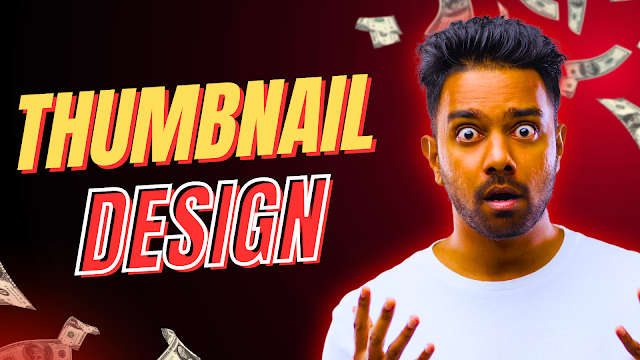Thumbnail Design: Capturing Attention in a Split Second
In a world flooded with digital content, attention has become one of the most valuable currencies. Every time a user scrolls through a social media feed, browses YouTube, or explores a digital marketplace, they are bombarded with images fighting for their attention. Among the most powerful visual elements in this battle are thumbnails. A thumbnail may seem small and simple, but its design can determine whether content is ignored or explored.
A thumbnail is essentially a visual preview. It represents the content before the user decides to click. On platforms like YouTube, a thumbnail often makes the difference between a viral video and one that remains unseen. In online stores, thumbnails of products can affect purchasing decisions. In blog directories, they can influence which article a reader opens first. For all these reasons, thumbnail design is a crucial skill for anyone involved in digital content creation.
One of the key goals of thumbnail design is to grab attention instantly. People often make decisions in a fraction of a second. The design must pop out visually, be easy to understand, and communicate its purpose without needing explanation. This is where visual hierarchy becomes essential. The most important element must be the most visible. Whether it is a face, a word, or a symbol, it must stand out clearly.
Bold colors are a common feature of effective thumbnails. They stand out against the typically neutral backgrounds of websites and apps. But using color is not just about brightness. It’s about contrast. Placing light text on a dark background, or using complementary color combinations, helps guide the viewer's eye to the right spot. At the same time, colors must align with the brand or tone of the content.
Typography in thumbnails also plays a vital role. Text must be large, clear, and easy to read, even on small screens. Many users will view thumbnails on mobile devices, so small or decorative fonts often fail to deliver. Short, punchy words or phrases work best. They give a quick idea of what the content is about. Instead of long titles, successful thumbnails often feature just a few impactful words that spark curiosity.
Faces, especially expressive ones, are powerful elements in thumbnail design. Human beings are naturally drawn to faces and emotions. A surprised look, a smile, or a dramatic expression can convey emotion more effectively than words. This is why many creators feature their own faces or those of others in thumbnails. It humanizes the content and builds a quick connection with the viewer.
Consistency is another important factor, especially for content creators who produce regular content. A recognizable style of thumbnail builds familiarity and trust. It could be a consistent color palette, layout, font style, or logo placement. When users start recognizing a certain style as belonging to a creator they like, they’re more likely to click again. It becomes part of the brand identity.
Clarity and simplicity are essential. While the temptation to add too many elements is strong, cluttered thumbnails often fail. They confuse rather than attract. A clear focal point, enough negative space, and a clean layout are better than crowded visuals. Each element must earn its place and support the overall goal: encouraging the click.
Thumbnails must also align with the content they represent. Misleading thumbnails might attract initial clicks, but they hurt credibility and retention. If the thumbnail promises one thing but the content delivers another, users feel tricked and may not return. Thumbnails must build trust by accurately previewing what’s inside.
Another important consideration is platform-specific optimization. Different platforms have different size recommendations and user behaviors. A thumbnail that works on YouTube might not work on Instagram or an eCommerce platform. Designers need to understand the context and design accordingly. For example, product thumbnails on online shops should showcase the item clearly, while social media thumbnails might focus more on emotion or storytelling.
Thumbnails also serve SEO purposes. Platforms use image recognition and metadata, including alt text and file names, to index content. Including relevant keywords in filenames and making sure the visual matches the content topic can slightly influence discoverability, especially on visual search engines.
Creating a great thumbnail is both an art and a science. It involves creativity, strategy, and testing. Many successful content creators use A/B testing to compare different thumbnail styles. Small changes in color, wording, or imagery can dramatically affect click-through rates. Over time, testing helps designers understand what resonates most with their audience.
Design tools like Photoshop, Canva, Figma, and online thumbnail generators have made the creation process easier. Templates can speed up workflow, but it’s the human touch that brings originality. Understanding the target audience, the content type, and the platform is key to creating thumbnails that don’t just look good, but perform well.
In addition, thumbnails must be optimized for speed. Large file sizes can slow down page loading, especially on mobile devices. Compressed, high-quality images ensure both visual impact and performance. Designers must balance sharpness and file size carefully.
Finally, a successful thumbnail sparks curiosity. It creates a question in the viewer’s mind: What’s this about? What happens next? Can I learn something from this? Will I be entertained or surprised? These questions lead to clicks. And every click is a small victory in a crowded digital space.
In summary, thumbnail design is far more than decoration. It is a critical component of online success. It demands clarity, creativity, relevance, and emotional intelligence. A great thumbnail invites viewers in, builds trust, and increases engagement. For anyone publishing digital content, mastering thumbnail design is not just helpful—it’s essential.


